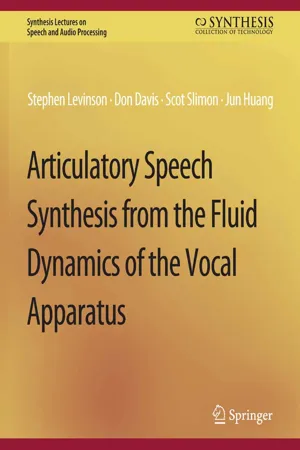
Articulatory Speech Synthesis from the Fluid Dynamics of the Vocal Apparatus
Stephen Levinson,Don Davis,Scott Slimon,Jun Huang
- English
- PDF
- Available on iOS & Android
Articulatory Speech Synthesis from the Fluid Dynamics of the Vocal Apparatus
Stephen Levinson,Don Davis,Scott Slimon,Jun Huang
About This Book
This book addresses the problem of articulatory speech synthesis based on computed vocal tract geometries and the basic physics of sound production in it. Unlike conventional methods based on analysis/synthesis using the well-known source filter model, which assumes the independence of the excitation and filter, we treat the entire vocal apparatus as one mechanical system that produces sound by means of fluid dynamics. The vocal apparatus is represented as a three-dimensional time-varying mechanism and the sound propagation inside it is due to the non-planar propagation of acoustic waves through a viscous, compressible fluid described by the Navier-Stokes equations. We propose a combined minimum energy and minimum jerk criterion to compute the dynamics of the vocal tract during articulation. Theoretical error bounds and experimental results show that this method obtains a close match to the phonetic target positions while avoiding abrupt changes in the articulatory trajectory. The vocal folds are set into aerodynamic oscillation by the flow of air from the lungs. The modulated air stream then excites the moving vocal tract. This method shows strong evidence for source-filter interaction. Based on our results, we propose that the articulatory speech production model has the potential to synthesize speech and provide a compact parameterization of the speech signal that can be useful in a wide variety of speech signal processing problems. Table of Contents: Introduction / Literature Review / Estimation of Dynamic Articulatory Parameters / Construction of Articulatory Model Based on MRI Data / Vocal Fold Excitation Models / Experimental Results of Articulatory Synthesis / Conclusion
Frequently asked questions
Information
Table of contents
- Cover
- Copyright Page
- Title Page
- Contents
- Preface
- 1 Introduction
- 2 Literature Review
- 3 Estimation ofDynamic Articulatory Parameters
- 4 Construction of Articulatory Model Based on MRI Data
- 5 Vocal Fold Excitation Models
- 6 Experimental Results of Articulatory Synthesis
- 7 Conclusion
- Bibliography
- Authors’ Biographies